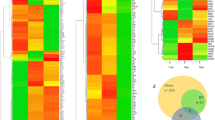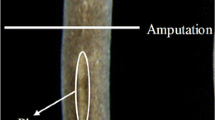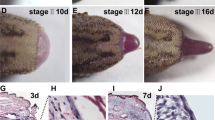Abstract
After planarian tail is cut off, posterior end of the remaining fragment will regenerate a new tail within about 1 week. However, many details of this process remain unclear up to date. For this reason, we performed the dynamic proteomic analysis of the regenerating tail fragments at 6, 12, 24, 72, 120, and 168 h post-amputation (hpa). Using two-dimensional electrophoresis (2-DE) in combination with MALDI-TOF-TOF/MS analysis, a total of 1088 peptides were identified as significantly changed between tail-cutting groups and 0-h group, 482 of which have identifiable protein names. Of these 482 proteins, there were 111 originating from the Turbellaria. Protein functional categorization showed that these 111 proteins are mainly related to differentiation and development, transcription and translation, cell signal transduction, and cell proliferation. The screening of key protein considered the transcription factor Smad4 as important protein for planarian tail regeneration. Cell signaling pathway analysis, combined with proteomic profiling of regenerating tail fragment, showed that TGFβ/Smad4 pathway was activated during planarian tail regeneration. Based on a comprehensive analysis of 2-DE MALDI-TOF-TOF/MS and bioinformatics analyses, it could be concluded that TGFβ/Smad4 pathway perhaps plays an important role in tail regeneration via promoting cell differentiation.




Similar content being viewed by others
Abbreviations
- Hpa:
-
Hours post-amputation
- CNS:
-
Central nervous system
- CHAPS:
-
3-((3-Cholamido-propyl) dimethylammonio)-1-propanesulfonate
- IEF:
-
Isoelectric focusing
- CBB:
-
Coomassie brilliant blue
- HCCA:
-
α-Cyano-4-hydroxycinnamic acid
- TFA:
-
Trifluoroacetic acid
- ACN:
-
Acetonitrile
- qRT-PCR:
-
Quantitative real-time PCR
- SNR:
-
Signal to noise ratio
- RFSC:
-
Revised feature score criterion
- BD:
-
Bhattacharyya distance
- ED:
-
Euclidean distance
- PCC:
-
Pearson correlation coefficient
- FC:
-
Fold change
References
Gentile, L., Cebrià, F., & Bartscherer, K. (2011). The planarian flatworm: an in vivo model for stem cell biology and nervous system regeneration. Disease Models & Mechanisms, 4, 12–19.
Newmark, P. A., Wang, Y., & Chong, T. (2008). Germ cell specification and regeneration in planarians. Cold Spring Harbor Symposia on Quantitative Biology, 73, 573–581.
Sikes, J. M., & Newmark, P. A. (2013). Restoration of anterior regeneration in a planarian with limited regenerative ability. Nature, 500, 77–80.
Yazawa, S., Umesono, Y., Hayashi, T., Tarui, H., & Agata, K. (2009). Planarian Hedgehog/Patched establishes anterior-posterior polarity by regulating Wnt signaling. Proceedings of the National Academy of Sciences U S A, 106, 22329–22334.
Adell, T., Cebrià, F., & Saló, E. (2010). Gradients in planarian regeneration and homeostasis. Cold Spring Harbor Perspectives in Biology, 2, a000505.
Baguñà, J., Romero, R., Saló, E., Collet, J., Auladell, C., Ribas, M., Riutort, M., García-Fernàndez, J., Burgaya, F., & Bueno, D. (1990). Growth, degrowth and regeneration as developmental phenomena in adult freshwater planarians. In H.-J. Marthy (Ed.), Experimental embryology in aquatic plants and animals (pp. 129–162). New York: Plenum Press.
Newmark, P. A., & Sánchez Alvarado, A. (2000). Bromodeoxyuridine specifically labels the regenerative stem cells of planarians. Developmental Biology, 220, 142–153.
Agata, K., & Umesono, Y. (2008). Brain regeneration from pluripotent stem cells in planarian. Philosophical Transactions of the Royal Society of London. Series B, Biological Sciences, 363, 2071–2078.
Sandmann, T., Vogg, M. C., Owlarn, S., Boutros, M., & Bartscherer, K. (2011). The head-regeneration transcriptome of the planarian Schmidtea mediterranea. Genome Biology, 12, R76.
Liu, S. Y., Selck, C., Friedrich, B., Lutz, R., Vila-Farré, M., Dahl, A., Brandl, H., Lakshmanaperumal, N., Henry, I., & Rink, J. C. (2013). Reactivating head regrowth in a regeneration-deficient planarian species. Nature, 500, 81–84.
Fraguas, S., Barberán, S., Iglesias, M., Rodríguez-Esteban, G., & Cebrià, F. (2014). Egr-4, a target of EGFR signaling, is required for the formation of the brain primordia and head regeneration in planarians. Development, 141, 1835–1847.
Conte, M., Deri, P., Isolani, M. E., Mannini, L., & Batistoni, R. (2009). A mortalin-like gene is crucial for planarian stem cell viability. Development Biology, 334, 109–118.
Rink, J. C., Vu, H. T., & Sánchez Alvarado, A. (2011). The maintenance and regeneration of the planarian excretory system are regulated by EGFR signaling. Development, 138, 3769–3780.
Hubert, A., Henderson, J. M., Ross, K. G., Cowles, M. W., Torres, J., & Zayas, R. M. (2013). Epigenetic regulation of planarian stem cells by the SET1/MLL family of histone methyltransferases. Epigenetics, 8, 79–91.
Kao, D., Felix, D., & Aboobaker, A. (2013). The planarian regeneration transcriptome reveals a shared but temporally shifted regulatory program between opposing head and tail scenarios. BMC Genomics, 14, 797.
Kaur, B., Sharma, M., Soni, R., Oberoi, H. S., & Chadha, B. S. (2013). Proteome-based profiling of hypercellulase-producing strains developed through interspecific protoplast fusion between Aspergillus nidulans and Aspergillus tubingensis. Applied Biochemistry and Biotechnology, 169, 393–407.
Tejada-Romero, B., Carter, J. M., Mihaylova, Y., Neumann, B., & Aboobaker, A. A. (2015). JNK signalling is necessary for a Wnt- and stem cell-dependent regeneration programme. Development, 142, 2413–2424.
Gurley, K. A., Elliott, S. A., Simakov, O., Schmidt, H. A., Holstein, T. W., & Sánchez Alvarado, A. (2010). Expression of secreted Wnt pathway components reveals unexpected complexity of the planarian amputation response. Developmental Biology, 347, 24–39.
Gurley, K. A., Rink, J. C., & Sánchez Alvarado, A. (2008). Beta-catenin defines head versus tail identity during planarian regeneration and homeostasis. Science, 319, 323–327.
Long, A. B., Kaiser, W. J., Mocarski, E. S., & Caspary, T. (2013). Apaf1 apoptotic function critically limits Sonic hedgehog signaling during craniofacial development. Cell Death and Differentiation, 20, 1510–1520.
Reuter, H., März, M., Vogg, M. C., Eccles, D., Grífol-Boldú, L., Wehner, D., Owlarn, S., Adell, T., Weidinger, G., & Bartscherer, K. (2015). β-Catenin-Dependent Control of Positional Information along the AP Body Axis in Planarians Involves a Teashirt Family Member. Cell Report, 10, 253–265.
Fraguas, S., Barberán, S., & Cebrià, F. (2011). EGFR signaling regulates cell proliferation, differentiation and morphogenesis during planarian regeneration and homeostasis. Developmental Biology, 354, 87–101.
Adler, C. E., Seidel, C. W., McKinney, S. A., & Sánchez Alvarado, A. (2014). Selective amputation of the pharynx identifies a FoxA-dependent regeneration program in planaria. eLife, 3, e02238.
Salo, E., Pineda, D., Marsal, M., Gonzalez, J., Gremigni, V., & Batistoni, R. (2002). Genetic network of the eye in Platyhelminthes: expression and functional analysis of some players during planarian regeneration. Gene, 287, 67–74.
Irvine, S. Q., & Martindale, M. Q. (2000). Expression patterns of anterior Hox genes in the polychaete Chaetopterus: correlation with morphological boundaries. Developmental Biology, 217, 333–351.
Isolani, M. E., Abril, J. F., Saló, E., Deri, P., Bianucci, A. M., & Batistoni, R. (2013). Planarians as a model to assess in vivo the role of matrix metalloproteinase genes during homeostasis and regeneration. PLoS One, 8, 55649.
Cebrià, F., & Newmark, P. A. (2007). Morphogenesis defects are associated with abnormal nervous system regeneration after roboA RNAi in planarians. Development, 134, 833–837.
Saló, E., Tauler, J., Jimenez, E., Bayascas, J. R., Gonzalez, J., Garcia Fernandez, J., & Baguña, J. (2001). Hox and parahox genes in flatworms: characterization and expression. American Zoologist, 41, 652–663.
Callaerts, P., Muñoz-Marmol, A. M., Glardon, S., Castillo, E., Sun, H., Li, W. H., Gehring, W. J., & Saló, E. (1999). Isolation and expression of a Pax-6 gene in the regenerating and intact Planarian Dugesia(G)tigrina. Proceedings of the National Academy of Sciences U S A, 96, 558–563.
Reddien, P. W., Bermange, A. L., Murfitt, K. J., Jennings, J. R., & Sánchez Alvarado, A. (2005). Identification of genes needed for regeneration, stem cell function, and tissue homeostasis by systematic gene perturbation in planaria. Developmental Cell, 8, 635–649.
Weimer, J. M., Stanco, A., Cheng, J. G., Vargo, A. C., Voora, S., & Anton, E. S. (2008). A BAC Transgenic Mouse Model to Analyze the Function of Astroglial SPARCL1 (SC1) in the Central Nervous System. Glia, 56, 935–941.
Rouhana, L., Shibata, N., Nishimura, O., & Agata, K. (2010). Different requirements for conserved posttranscriptional regulators in planarian regeneration and stem cell maintenance. Developmental Biology, 341, 429–443.
Salvetti, A., Batistoni, R., Deri, P., Rossi, L., & Sommerville, J. (1998). Expression of DjY1, a protein containing a cold shock domain and RG repeat motifs, is targeted to sites of regeneration in planarians. Developmental Biology, 201, 217–229.
Di Bernardini, E., Campagnolo, P., Margariti, A., Zampetaki, A., Karamariti, E., Hu, Y., & Xu, Q. (2014). Endothelial lineage differentiation from induced pluripotent stem cells is regulated by microRNA-21 and transforming growth factor β2 (TGF-β2) pathways. Journal of Biological Chemistry, 289, 3383–3393.
Gonzalez-Sastre, A., Molina, M. D., & Salo, E. (2012). Inhibitory Smads and bone morphogenetic protein (BMP) modulate anterior photoreceptor cell number during planarian eye regeneration. International Journal of Developmental Biology, 56, 155–163.
Leonardo, R., Alessandra, S., Francesco, M. M., Annalisa, L., Paolo, D., Linda, M., Renata, B., Ena, W., & Vittorio, G. (2007). Deciphering the molecular machinery of stem cells: a look at the neoblast gene expression profile. Genome Biology, 8, R64.
Shibata, N., Hayashi, T., Fukumura, R., Fujii, J., Kudome-Takamatsu, T., Nishimura, O., Sano, S., Son, F. Y., Suzuki, N., Araki, R., Abe, M., & Agata, K. (2012). Comprehensive gene expression analyses in pluripotent stem cells of a planarian, Dugesia japonica. International Journal of Developmental Biology, 56, 93–102.
Cebrià, F., & Newmark, P. A. (2007). Morphogenesis defects are associated with abnormal nervous system regeneration after roboA RNAi in planarians. Development, 134, 833–837.
Koinuma, S., Umesono, Y., Watanabe, K., & Agata, K. (2003). The expression of planarian brain factor homologs, DjFoxG and DjFoxD. Gene Expression Patterns, 3, 21–27.
Huang, Y., Li, Z., & Ye, Q. (2016). Transcriptional regulation of genes involved in 3-hydroxypropionic acid production in response to aeration of recombinant Klebsiella pneumoniae. Applied Biochemistry and Biotechnology, 178, 1129–1140.
Rao, N., Jhamb, D., Milner, D. J., Li, B., Song, F., Wang, M., Voss, S. R., Palakal, M., King, M. W., Saranjami, B., Nye, H. L., Cameron, J. A., & Stocum, D. L. (2009). Proteomic analysis of blastema formation in regenerating axolotl limbs. BMC Biology, 7, 83.
King, M. W., Neff, A. W., & Mescher, A. L. (2009). Proteomics analysis of regenerating amphibian limbs: changes during the onset of regeneration. The International Journal of Developmental Biology, 53, 955–969.
Padhi, B. K., Joly, L., Tellis, P., Smith, A., Nanjappa, P., Chevrette, M., Ekker, M., & Akimenko, M. A. (2004). Screen for genes differentially expressed during regeneration of the zebrafish caudal fin. Developmental Dynamics, 231, 527–541.
Nishidate, M., Nakatani, Y., Kudo, A., & Kawakami, A. (2007). Identification of novel markers expressed during fin regeneration by microarray analysis in medaka fish. Developmental Dynamics, 236, 2685–2693.
Umesono, Y., & Agata, K. (2009). Evolution and regeneration of the planarian central nervous system. Development, Growth & Differentiation, 51, 185–195.
Eguizabal, C., Montserrat, N., Veiga, A., & Izpisua Belmonte, J. C. (2013). Dedifferentiation, transdifferentiation, and reprogramming: future directions in regenerative medicine. Seminars in Reproductive Medicine, 31, 82–94.
Stoltz, J. F., Bensoussan, D., De Isla, N., Zhang, L., Han, Z., Magdalou, J., Huselstein, C., Ye, J. S., Li, N., Decot, V. & Reppel, L. (2016). Stem cells and vascular regenerative medicine. Clinical hemorheology and microcirculation.
Tasaki, J., Shibata, N., Nishimura, O., Itomi, K., Tabata, Y., Son, F., Suzuki, N., Araki, R., Abe, M., Agata, K., & Umesono, Y. (2011). ERK signaling controls blastema cell differentiation during planarian regeneration. Development, 138, 2417–2427.
Penheiter, S. G., Mitchell, H., Garamszegi, N., Edens, M., Doré Jr., J. J., & Leof, E. B. (2002). Internalization-dependent and -independent requirements for transforming growth factor beta receptor signaling via the Smad pathway. Molecular and Cellular Biology, 22, 4750–4759.
Friedman, M., & Ståhl, S. (2009). Engineered affinity proteins for tumour-targeting applications. Applied Biochemistry and Biotechnology, 53, 1–29.
Aoki, M., Yamashita, T., & Tohyama, M. (2004). EphA receptors direct the differentiation of mammalian neural precursor cells through a mitogen-activated protein kinase-dependent pathway. Journal of Biological Chemistry, 279, 32643–32650.
Sánchez Alvarado, A., & Tsonis, P. A. (2006). Bridging the regeneration gap: genetic insights from diverse animal models. Nature Reviews Genetics, 7, 873–884.
Hueston, J. L., & Suprenant, K. A. (2009). Loss of dystrophin and the microtubule-binding protein ELP-1 causes progressive paralysis and death of adult C. elegans. Developmental Dynamics, 238, 1878–1886.
Runser, S., & Cerletti, N. (1995). Transforming growth factors beta: conformational stability and features of the denaturation of recombinant human transforming growth factors beta 2 and beta 3. Applied Biochemistry and Biotechnology, 22, 39–53.
Owens, P., Bazzi, H., Engelking, E., Han, G., Christiano, A. M., & Wang, X. J. (2008). Smad4-dependent desmoglein-4 expression contributes to hair follicle integrity. Developmental Biology, 322, 156–166.
Song, B., Estrada, K. D., & Lyons, K. M. (2009). Smad signaling in skeletal development and regeneration. Cytokine Growth Factor Review, 20, 379–388.
Orii, H., & Watanabe, K. (2007). Bone morphogenetic protein is required for dorso-ventral patterning in the planarian Dugesia Japonica. Development, Growth & Differentiation, 49, 345–349.
Reddien, P. W., Bermange, A. L., Kicza, A. M., & Sánchez Alvarado, A. (2007). BMP signaling regulates the dorsal planarian midline and is needed for asymmetric regeneration. Development, 134, 4043–4051.
Molina, M. D., Salò, E., & Cebrià, F. (2007). The BMP pathway is essential for re-specification and maintenance of the dorsoventral axis in regenerating and intact planarians. Developmental Biology, 311, 79–94.
Acknowledgements
Our work has been financially supported by the National Natural Science Foundation of China (No. 31401209).
Author information
Authors and Affiliations
Corresponding author
Rights and permissions
About this article
Cite this article
Chen, X., Xu, C. Proteomic Analysis Reveals the Contribution of TGFβ/Smad4 Signaling Pathway to Cell Differentiation During Planarian Tail Regeneration. Appl Biochem Biotechnol 182, 529–545 (2017). https://doi.org/10.1007/s12010-016-2342-y
Received:
Accepted:
Published:
Issue Date:
DOI: https://doi.org/10.1007/s12010-016-2342-y




